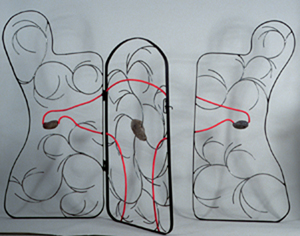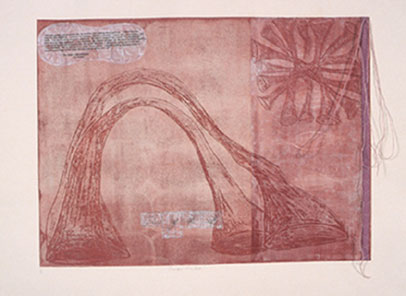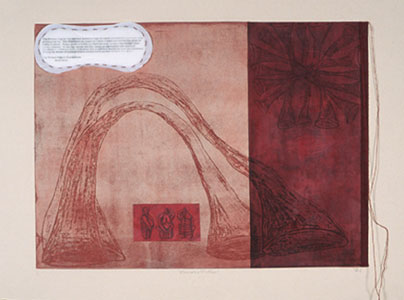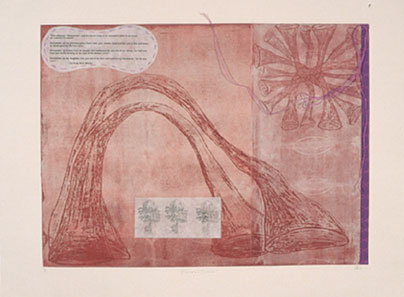See art by Mayra Alpízar | Carlota Berard | Jennifer Boe | Roz Bonnet | Luiza Brown | Nikoline
Calcaterra | Judy
Chicago | Selin
Cileli | Maldoror
Capvt
Corvi | Maribel
Cruz | Thomasin
Durgin | Natalie
Aniela Dybisz | Elvira
| Anne Encephalon
| Hélène Epaud | Quiara Z. Escobar | Fanni Fazekas | Pat Fish | Julie Gaw | Gina | Kat Grandy | Martina
Hoffmann (1 & 2) | Jelena | Judy Jones | Margaret Kalms | Brina Katz | Lorraine Lamothe | Ria Lee | Sharon Lee | Lana Leitch | Carol
Nathan Levin | Katy
Luxion | Sarah
McCutcheon | Isa
Menzies | Megan
Morris | M.
Parfitt | Petra
Paul | Ana Elena
Pena | Melina
Piroso | Elentye
Paulauskas-Poelker | Leigh Radtke | Jacquelyn Rixon | Isa Sanz | Vladislav Shabalin |
Nelson Soucasaux |
Paula Speakman | Alexandra
Steiner | Melina
Szapiro | Von
Taylor | Jean
Tracy | Joseph
Tonna | Jessica Wagner | Jennifer Weigel | Terry Wunderlich | Tamara Wyndham | New Guinea menstrual
hut carving
|
|
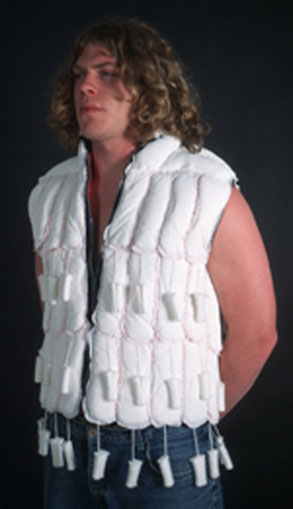 |
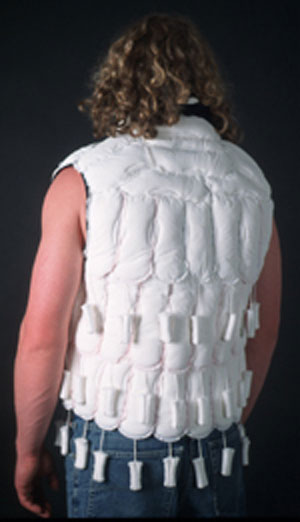 |
(above and below) "Padded"
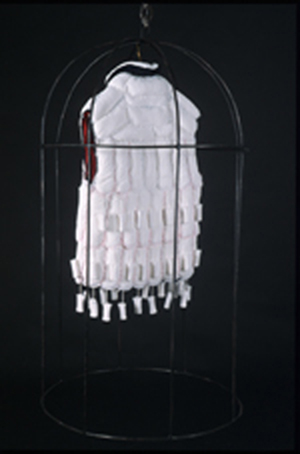 |
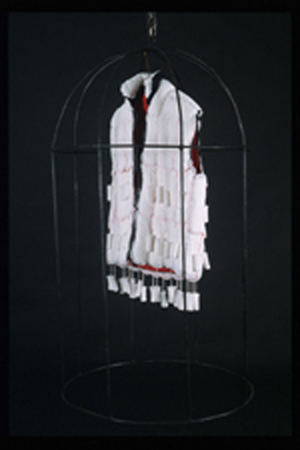 |
(below) Menses: Maiden , Mother, Crone
|
Maiden |
|
Mother |
|
Crone |
The artist, Nikoline CalcaterraIntroduction Presently, I am working as both a multi-media artist and as the Program Coordinator at White Mountain Academy of the Arts, in Elliot Lake, Ontario. Throughout my life, art has been a source of comfort, insight and beauty, from literature to music to visual art. It brings tears to my eyes to remember waking up in the middle of the night as a young girl, to the sound of my mother's typewriter as she vigorously released her response from the day past. This was the only spare time she could find, after her role as mother and wife. Today, she has fulfilled her dream. As an adult, I still get chills when I hear Mozart and Bach. It reminds me of our old upright piano and takes me back to a time when things were straightforward, to a time when all of life's questions were answered by a simple emotional response. If reading "Anne of Green Gables" or listening to Mozart made me cry, I did not question why, I simply accepted the sadness as my response to the art. This concept of the emotional response has become my main inspiration behind my present body of work. The work is an emotional response to both my conscious and subconscious observations as a lesbian woman. Although my work is supported by research, the root of my observation is gathered following the works creation. Some believe that this method is backwards in its execution, but I believe that by working from the emotional response, I am maintaining the purity of the thought, with few outside influences. Artist's Statement My inspiration stems from being woman and needing to release my emotional response to all that I observe in this form and on this Earthwalk. I fail to understand this worlds inability to see things for what they are. Therefore, I feel the need to create discussions that often go unexpressed. Woman bleeds. Blood is life. Life is beyond control. I am inspired by life, and the emotions involved in holding the position of woman. I am inspired by love and the emotions invested in loving another called "woman." I am inspired by women and the emotions generated when circles are formed. I am inspired by the Great Mother and the emotions surrounding her creation and destruction. The work I create reflects emotions involving gender identity related to woman and her journey, from birth to her passage through the veil, and beyond. "Creation Circuit" I entered into a discussion with a friend about the possibility of having a child with my current partner. I mentioned that we were considering a few options, including finding a suitable sperm donor. She looked at me with confusion and said, "Why do you need a sperm donor? Why can't the two of you have a baby?" I gave her a minute to process what she had just said, and then the light came on. "Oh my Goddess! I had never thought about the fact that you are both women!" This conversation inspired me to make Creation Circuit. Creation Circuit is a three piece steal gate that attaches to a tall blood red picket fence. The two outer gate pieces, each 5.5' x 2.5', are bent into the vague silhouettes of women facing into each other. The centre gate piece that acts as the door is a 4.75' x 2.5' rounded rectangle. The centre of each piece contains a series of brushed steel circular vines that indicate a spiral growth pattern, moving in and out of each piece. In the centre of the door piece is a stone that appears to be the source of the surrounding growth. In all three pieces there is a series of 1/2" round bar painted blood red that on either end piece, joins up to an oval stone. When all three gate pieces are lined up, the spiral growth, the red round bar and the stones inside the gate frame become a large image of what I imagine procreation by two females would look like. The red round bar forms the vagina, cervix and uterus in the door piece, and the fallopian tubes in the two outside pieces. The oval stones in the two outside pieces are the ovaries, and the stone in the door piece is the egg having been fertilized and is beginning its growth. I have always pictured the chemistry of the first moments of a fertilized egg to be like fireworks, an explosion of hormones and DNA. Although it is fully functional outside, it is meant to be installed in a gallery so that the red picket fence follows along the walls of the entire gallery space and the gate is the means of entrance into the exhibition space. Creation Circuit is about menstruation, procreation, sexuality, life, etc., and is meant to look at why our society finds it so hard to accept that those who bleed and give life, can also love and nurture and provide for that life together. "Padded" - (Images 1 to 4) "Padded" was inspired, in part by my recent introduction to homemade, terry cloth menstrual nappies, and in part by Gloria Steinem's essay entitled, If Men Could Menstruate. "Padded" was created by covering a XL fleece vest with clean, fresh, whiter-than-white menstrual pads in a pattern that mimicked a quilted down ski vest sized to fit a large male. The tampons were added as decoration, loosely referring to the North American native cultures that would honour woman during her moon-time by isolating her in a menstrual hut where she could be with her powerful energy. The inside lining of the vest is made of red broadcloth, which represents the blood being contained inside the body instead of being aloud to run out from the body. It also refers to the disconnection women have with their blood now that disposable menstrual products have replaced the reusable, re-washable pad. Women no longer have to look, touch or smell their power. They simple contain, dispose and ignore the gift that separates and honours them as women. The vest hangs in a steel cage, 70 x 70 x 90 cm, much like a bird cage only bottomless. This refers to women as beings caged by patriarchy for their "bloody inconvenience", but continue to repress themselves by refusing to escape from the cage walls. Tampons, although dangerous and unnatural, are very convenient and allow women to ignore their moon-time and move forward in the male-dominated work world, becoming much like man, obsessed with time, money and convenience. The result is a new generation of woman who are disconnected from the rituals of blood that define them as strong, powerful, givers of life, who instead view blood as a dirty curse that causes discomfort and inconvenience each month, beginning at puberty and ending with menopause. The vest is fitted for a large male frame, and is meant to be worn by a model as a format for exhibition. This is a commentary on Gloria Steinem's essay, If Men Could Menstruate:
It is with the above in mind, that I challenge the male ego to step up and wear this vest in honour of all the women in their lives who have had to face the stigma of being the gender that bleeds and therefore gives life to this world. Menses: Maiden, Mother, Crone Series (images 5 - 8) The Menses series was inspired mainly by a birthing retreat I attended with my partner and seven other women, two of whom were lesbians, four sexual abuse victims, four retired nurses, two healing artists, two visual artists and five Crones. Among many other incredible discussions that went on during this weekend, was one regarding the story of our first menses. What came out of this recollection, this deep soul searching, was a flush of emotion; laughter, tears, anger, hysteria, embarrassment, . . . laughter, and what we began to realize, was how little attention we had aloud to this moment, how little attention the world allows to this moment. For the women, the experience of our first menses was not too far gone, but for the Crones, this memory was stored, and in most cases hidden behind 40 or 50 years of memories. We discussed blood, mothers, cramps, fathers, secrets, embarrassing moments, misunderstandings, tampons, terry cloth nappies and menstrual pad belts! Throughout the weekend, we as women honoured each stage of the female life, from Maiden to Woman to Crone, and aloud each moment the attention that it deserved. From this experience comes the Menses series. Menses: Maiden, Mother, Crone all begin with the same imprinted background of blood red disposable pads and the same foreground image of an entanglement of tubes in the top right hand corner, with a detail of those same tubes spanning the length of the paper. These tubes represent the inner workings of the female body during so many moments in our lives, from the umbilical cord to the birth canal to the fallopian tubes. Menses: Maiden has white Japanese rice paper chinchölé on the right third of the image. This is to symbolize the portion of purity a Maiden still holds prior to her first menses. On the bottom centre of the image, the famous "Tampax Insertion Instructions" have been transferred onto the same white rice paper. This image describes the anxiety and confusion that so many Maidens go through prior to bleeding. "They want me to stick what into where?!" In the top left hand corner, there is the same white rice paper cut into the shape of a pad with the following words written by Eve Ensler:
-The Vagina Monologues On the far left hand side of the image, on the edge of the white chinchölé, is a pink ribbon that is laced to the paper with pink embroidery floss in the style that corsets were laced. In many rituals, ribbons are given to women as a way to mark certain moments in their lives. Pink represents the Maiden and the lacing describes the repression young Maidens experience by being kept silent about one of the most precious moments of their lives Menses: Mother has red hand-watercoloured Japanese rice paper chinchölé on the right third of the image. This represents the blood of a Woman. The blood of the menses, the blood of the broken hymen and the blood spilled during childbirth. On the bottom centre of the image is a transfer on the same red watercoloured rice paper, of a Maltese statue symbolizing the birthing process. Her vulva is swollen and open and her legs are held high and wide. On her back are nine lines that represent the nine months of carrying the child in her womb. On the top left hand corner of the image is a disposable menstrual pad with the following words written by Jamie Sams:
-The Thirteen Original Clan Mothers On the far left hand side of the image, on the edge of the red watercoloured rice paper, is a red ribbon laced on to the paper with red embroidery floss in the style that corsets were laced. In many rituals, women are given red ribbons when they begin their menses. The lacing represents the repression and embarrassment that women are made to feel about their moontimes and all that is involved with this process. Menses: Crone has cream coloured Japanese rice paper chinchölé on the right third of the image. This represents the memory of blood, the shadow. On the bottom centre of the image is a transfer on the same cream coloured rice paper of sage bundles. Sage is thought to hold the power of immortality, longevity and wisdom, much like a crone. On the top right corner is the shadow of a menstrual pad with the following words written by Kelly Rose Mason:
On the far left hand side of the image, on the edge of the cream coloured rice paper, is a purple ribbon laced on to the paper with purple embroidery floss in the style that corsets were laced. In many rituals, women are given purple ribbons when they stop flowing. It is a way to honour the Crone for her wisdom and knowledge. This lacing represents the repression and embarrassment that Crones are made to feel about aging and losing their ability to create life. The Menses series is in response to the ongoing battle women face because they do in fact bleed. |
NEXT artist:
Judy Chicago
|



